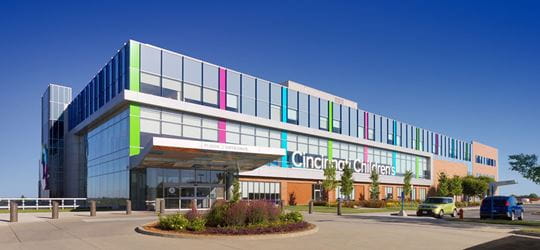Peter de Blank, MD, MSCE
- Co-Medical Director, Brain Tumor Center
- Professor, UC Department of Pediatrics
- peter.deblank@cchmc.org
- Board Certified
About
Biography
I graduated from the University of California, San Francisco School of Medicine with a concentration in Medical Education. I completed my residency in Pediatrics, and fellowships in Pediatric Hematology & Oncology and Pediatric Neuro-Oncology at the Children’s Hospital of Philadelphia. During my fellowship training, I also completed a Master of Science in Clinical Epidemiology and Biostatistics at the University of Pennsylvania. After completing my training, I became a faculty member at University Hospitals Rainbow Babies & Children’s Hospital in Cleveland in 2012. In 2017, I joined the faculty at Cincinnati Children’s as a member of the Pediatric Neuro-Oncology program.
My clinical and research interests include children with central nervous system tumors, neurofibromatosis type 1 (NF1), and NF1-related tumors. My research focuses on investigating tissue microstructure in pediatric brain tumors through non-invasive imaging techniques such as MR relaxometry and diffusion tensor imaging. The goal of my research is to develop early radiographic tumor biomarkers to characterize pediatric brain tumors and predict their functional consequences. Tumor imaging research may guide early intervention efforts and direct support for children with brain tumors to improve clinical outcomes.
I have been elected by peers for inclusion in the Best Doctors in America List.
BA: Stanford University, Stanford, CA, 1997.
BS: Chemistry, Stanford University, Stanford, CA, 1997.
MA: Stanford University, Stanford, CA, 1997.
MD: Emphasis in Medical Education, University of California, San Francisco School of Medicine, San Francisco, CA, 2005.
MS: Clinical Epidemiology, University of Pennsylvania, Center for Clinical Epidemiology and Biostatistics, Philadelphia, PA, 2011.
Intern: Pediatrics, The Children’s Hospital of Philadelphia, Philadelphia, PA, 2005-2006.
Resident: Pediatrics, The Children’s Hospital of Philadelphia, Philadelphia, PA, 2006-2008.
Fellow: Pediatric Hematology and Oncology, The Children’s Hospital of Philadelphia, Philadelphia, PA, 2008-2011; Pediatric Neuro-Oncology, The Children’s Hospital of Philadelphia, Philadelphia, PA, 2011-2012.
Interests
Pediatric neuro-oncology; neurofibromatosis type 1 (NF1); NF1-associated brain tumors
Services and Specialties
Interests
Cancer imaging; diffusion tensor imaging; MR relaxometry; magnetic resonance fingerprinting; developmental therapeutics
Research Areas
Locations (2)
Insurance Information
Cincinnati Children's strives to accept a wide variety of health plans. Please contact your health insurance carrier to verify coverage for your specific benefit plan.
Publications
Late Morbidity and Mortality in Survivors of Childhood Ependymoma: A Report from the Childhood Cancer Survivor Study (CCSS). Cancers. 2025; 17:3669.
IMG-71. Stability of radiomics in pediatric medulloblastoma: a multi-institutional preliminary analysis. Neuro-Oncology. 2025; 27:v289-v290.
IMGP-04. Targetable somatostatin receptor expression assessed by DOTATATE PET imaging in children and young adults with recurrent/progressive high-risk central nervous system (CNS) tumors: Initial screening results from the CONNECT2007 Lutathera Phase I/II trial. Neuro-Oncology. 2025; 27:v311.
005 Baseline clinical characteristics of newly diagnosed optic pathway gliomas associated with NF1: results from the international multicenter NF1-OPG Natural History Study. Journal of American Association for Pediatric Ophthalmology and Strabismus. 2025; 29:104287.
BraTS-PEDs: Results of the Multi-Consortium International Pediatric Brain Tumor Segmentation Challenge 2023. 2025; 3:72-87.
Radiomic-based prognostic score for survival risk-stratification in pediatric medulloblastoma tumors: A multi-institutional study. Neuro-Oncology Advances. 2025; 7:vdaf107.
Isotretinoin has no effect on event-free survival across high-risk medulloblastoma molecular groups when added to maintenance: A secondary analysis of the Children's Oncology Group ACNS0332 data. Neuro-Oncology Advances. 2025; 7:vdaf054.
Neurocognitive outcomes and functional independence in adult survivors of childhood medulloblastoma diagnosed over 3 decades. Neuro-Oncology. 2025; 27:254-266.
PATH-13. MOLECULAR AND BIOLOGY CORRELATIVE RESULTS FROM THE PHASE 1B TRIAL OF UNESBULIN (PTC596) WITH RADIOTHERAPY IN CHILDREN NEWLY-DIAGNOSED WITH DIFFUSE INTRINSIC PONTINE GLIOMA (DIPG) AND HIGH-GRADE GLIOMA (HGG): A REPORT FROM THE COLLABORATIVE NETWORK FOR NEURO-ONCOLOGY CLINICAL TRIALS (CONNECT). Neuro-Oncology. 2024; 26:viii180.
Low-grade glioma in children with neurofibromatosis type 1: surveillance, treatment indications, management, and future directions. Child's Nervous System. 2024; 40:3241-3250.
From the Blog
Study: Improved Chemotherapy and Surgery Eliminating Need for Radiation for Low-Grade Gliomas
Peter de Blank, MD, MSCE3/4/2024







Patient Ratings and Comments
All patient satisfaction ratings and comments are submitted by actual patients and verified by a leading independent experience management company, Qualtrics. Patient identities are withheld to ensure confidentiality and privacy. Only those providers whose satisfaction surveys are administered through Cincinnati Children’s Hospital Medical Center are displayed. Click here to learn more about our survey